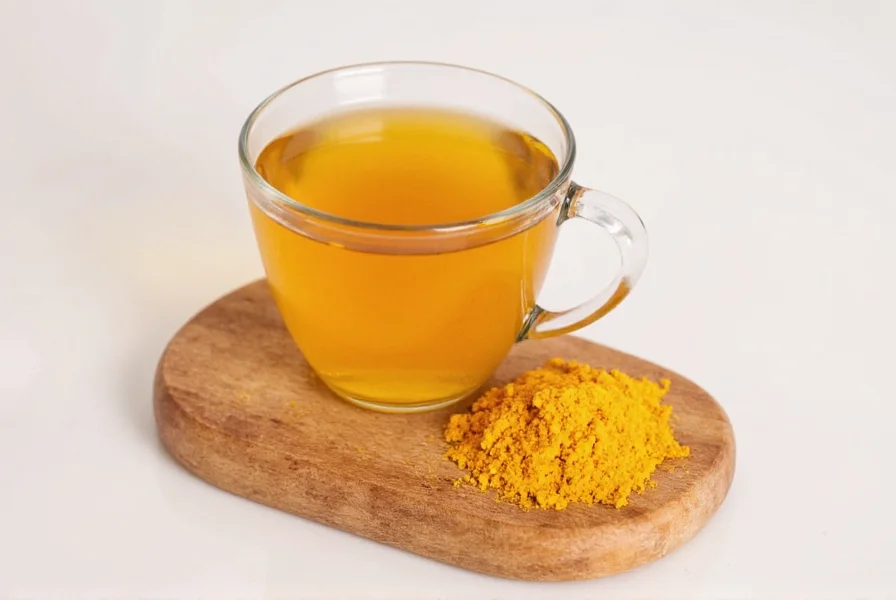Creating a perfect cup of turmeric tea requires understanding both the preparation method and the science behind its health benefits. This vibrant yellow beverage has gained popularity for its potential anti-inflammatory properties and immune-boosting effects. Whether you're using fresh turmeric root or powder, the preparation process remains straightforward while allowing for personal customization based on taste preferences and health goals.
Essential Ingredients for Turmeric Tea
The foundation of any quality turmeric tea recipe starts with selecting the right ingredients. While turmeric is the star, complementary ingredients enhance both flavor and bioavailability. Black pepper contains piperine, which increases curcumin absorption by up to 2000%, making it an essential addition to maximize health benefits.
| Ingredient | Standard Amount | Purpose |
|---|---|---|
| Fresh turmeric root | 1 teaspoon grated | Main active ingredient with curcumin |
| OR Turmeric powder | ½ teaspoon | Convenient alternative to fresh root |
| Water | 2 cups | Base liquid for infusion |
| Black pepper | ⅛ teaspoon | Enhances curcumin absorption |
| Lemon juice | 1 tablespoon | Adds vitamin C and balances flavor |
| Honey or maple syrup | To taste | Natural sweetener |
Step-by-Step Turmeric Tea Preparation
Follow these simple steps for a perfect cup of turmeric tea every time. This basic turmeric tea recipe serves as the foundation for numerous variations you can explore as you become more comfortable with the preparation process.
- Bring 2 cups of filtered water to a gentle boil in a small saucepan
- Add 1 teaspoon freshly grated turmeric root (or ½ teaspoon powder)
- Include ⅛ teaspoon freshly ground black pepper
- Reduce heat and simmer uncovered for 10-15 minutes
- Remove from heat and let steep for an additional 5 minutes
- Strain the tea into your favorite mug using a fine mesh strainer
- Add 1 tablespoon fresh lemon juice and sweetener to taste
- Stir well and enjoy while warm

Popular Turmeric Tea Variations
Once you've mastered the basic turmeric tea preparation method, experiment with these delicious variations that address different health needs and flavor preferences:
- Ginger-Turmeric Immunity Boost: Add 1 teaspoon freshly grated ginger during the simmering process for enhanced immune support
- Golden Milk Tea: Substitute 1 cup of water with unsweetened almond or coconut milk for a creamier texture
- Cinnamon Detox Tea: Include 1 cinnamon stick during simmering for blood sugar regulation benefits
- Cold Brew Turmeric Tea: Steep ingredients in cold water for 12 hours in the refrigerator for a refreshing summer beverage
Health Benefits of Regular Turmeric Tea Consumption
Understanding how to make turmeric tea properly maximizes its potential health advantages. The active compound curcumin provides numerous benefits when properly prepared:
- Reduces inflammation throughout the body, potentially helping with arthritis symptoms
- Supports digestive health by stimulating bile production
- Provides antioxidant protection against free radical damage
- May improve brain function and reduce risk of neurodegenerative diseases
- Supports heart health through improved endothelial function
Remember that consistent consumption yields better results than occasional drinking. For optimal absorption, always include black pepper and a healthy fat source like coconut oil or full-fat milk in your turmeric tea recipe.
Safety Considerations and Best Practices
While turmeric tea offers numerous benefits, follow these guidelines for safe consumption:
- Limited to 1-2 cups daily to avoid potential digestive upset
- Consult your physician if taking blood thinners, as turmeric may increase bleeding risk
- Pregnant women should consult healthcare providers before regular consumption
- Use organic turmeric when possible to avoid pesticide residues
- Store fresh turmeric root in the refrigerator for up to 2 weeks

Frequently Asked Questions
How long should I simmer turmeric for tea?
Simmer turmeric for 10-15 minutes to properly extract curcumin. Longer simmering (up to 20 minutes) creates a stronger flavor but may develop bitterness. Always keep the heat low to preserve the active compounds.
Can I make turmeric tea with ground turmeric instead of fresh root?
Yes, you can use ground turmeric as a convenient alternative. Use ½ teaspoon of high-quality turmeric powder per 2 cups of water. While fresh root contains slightly more curcumin, quality powder provides consistent results and longer shelf life.
Why add black pepper to turmeric tea?
Black pepper contains piperine, which increases curcumin absorption by up to 2000%. Without this addition, your body absorbs less than 1% of the curcumin. A mere ⅛ teaspoon of freshly ground black pepper significantly enhances the health benefits of your turmeric tea.
When is the best time to drink turmeric tea?
Drink turmeric tea in the morning to kickstart your day with anti-inflammatory benefits, or 30 minutes before bedtime to support restful sleep. Avoid drinking on an empty stomach if you have sensitive digestion. Many people find morning consumption provides sustained energy without caffeine crashes.











 浙公网安备
33010002000092号
浙公网安备
33010002000092号 浙B2-20120091-4
浙B2-20120091-4